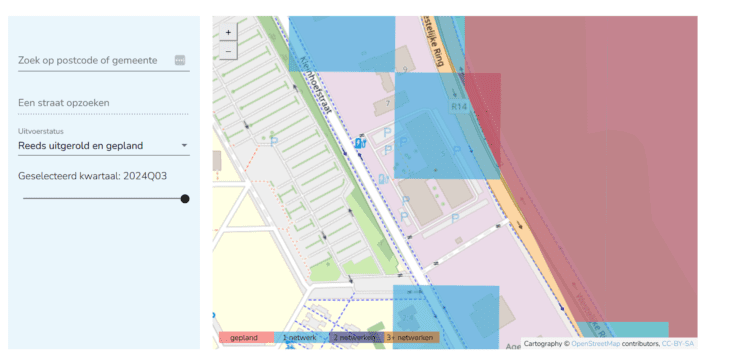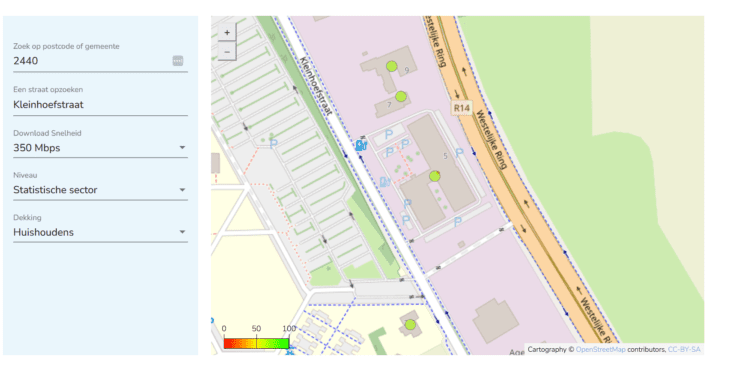How BIPT maps fixed and mobile networks
- October 10, 2024
- 0
With the BIPT network maps you can find out which network types are available on your street and at what speed. ITdaily takes a look behind the scenes
With the BIPT network maps you can find out which network types are available on your street and at what speed. ITdaily takes a look behind the scenes


With the BIPT network maps you can find out which network types are available on your street and at what speed. ITdaily takes a look behind the scenes and shows how the atlas was created.
Would you like to know whether there is already fiber optics on your street? Curious which municipality in Belgium has the fastest internet? The telecommunications regulator BIPT introduced network cards for fixed and mobile internet across Belgium at the end of 2022. In this digital atlas, available via the BIPT data portal, you can explore fixed, fiber, 4G and 5G network coverage in your region. You can zoom in on your address to see full details.
Following a public tender, BIPT enlisted the expert help of Agilytic, a Brussels-based data company, to develop the network cards. Yannick Dewilde, who will work on BIPT until May 2024, and Caroline Dozin, project manager at Agilytic, tell ITdaily how the collaboration went.
The network cards are the result of merging data. Which data exactly? “Data on addresses of households and companies comes from the land register of the Belgian state,” answers Dozin. “The operators then provide data about which network technology is available where and what speed is available at each location.”
“Operators’ predictions are validated against BIPT’s own measurements,” adds Dewilde. We have cars driving around and taking measurements. A subcontractor conducts tests to measure the customer experience, such as making calls and downloading files. With this data, BIPT wants to promote competition between operators. By offering this information to consumers in this way, they can compare themselves.”


All data sources then had to be processed into a visual representation that could be understood by the average consumer without a master’s degree in data analytics. Not an easy task, Dewilde remembers.
“Operators often have their own database and architecture of the telecommunications network. This makes it complex to bring everything together. Operators use different metrics or provide data in different formats. The maps also need to be updated several times a year. The maps have gradually become more precise down to the address level.”
Dozin mentions further difficulties. “We work with a lot of personal data. The sensitivity of the data is a challenge that we had to take into account. BIPT already had access to this data. You have given us a contract to process this data in accordance with GDPR legislation. When we ship address points to operators, we must be careful not to provide personal information about residents of the address.”
Dozin continues to explain how Agilytic works. “We always start from the business objectives and the available data. This was no different for this project, although the nature of the data was unique. Processing geographic data requires specialized skills. First, we had to examine the data and perform a quality check to identify any duplicate addresses or other inconsistencies. The business process then follows: What result do you want to achieve with the data? A non-technical person should be able to upload data and get the correct output.”
A tool was developed by the Agilytic team for this purpose. Dewilde: “The operators enter the data. These files are used in the tool to match the “pixels” so that the output is the same for all operators. Updating the portal used to be complex. The number of files has now been significantly reduced, but the KPIs have been streamlined even further.”
“We adapt to the requirements for performance and speed,” emphasizes Dozin. “The dashboard is updated several times a year. This allows for a longer process. It would be completely different if the data had to be updated daily. Then it’s all about creativity in order to be able to switch more quickly.”
The path to further optimization of the process is clear, says Dewilde. “Much complexity has already been removed, but human intervention remains necessary. The next step is to fully automate the process.”
“There is actually still human work between the output of the system and the input into the portal. But the output that the portal provides is readable by a non-analytical person. “In the next step, we want to develop a visualization tool for the BIPT teams themselves,” adds Dozin.
“Agilytic understands the needs of BIPT and also understands that the organization is not yet fully mature in data science. The path is now set for BIPT to further develop in this area and increase its level of maturity. Employees no longer have to call or email every time they need specific information. “That sounds like the basics, but it’s very important,” concludes Dewilde.
Source: IT Daily
As an experienced journalist and author, Mary has been reporting on the latest news and trends for over 5 years. With a passion for uncovering the stories behind the headlines, Mary has earned a reputation as a trusted voice in the world of journalism. Her writing style is insightful, engaging and thought-provoking, as she takes a deep dive into the most pressing issues of our time.